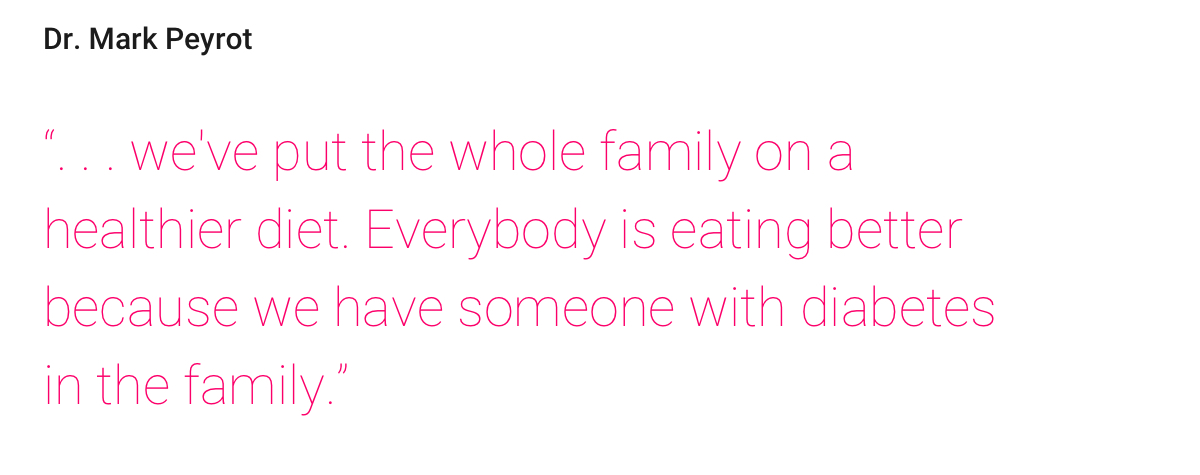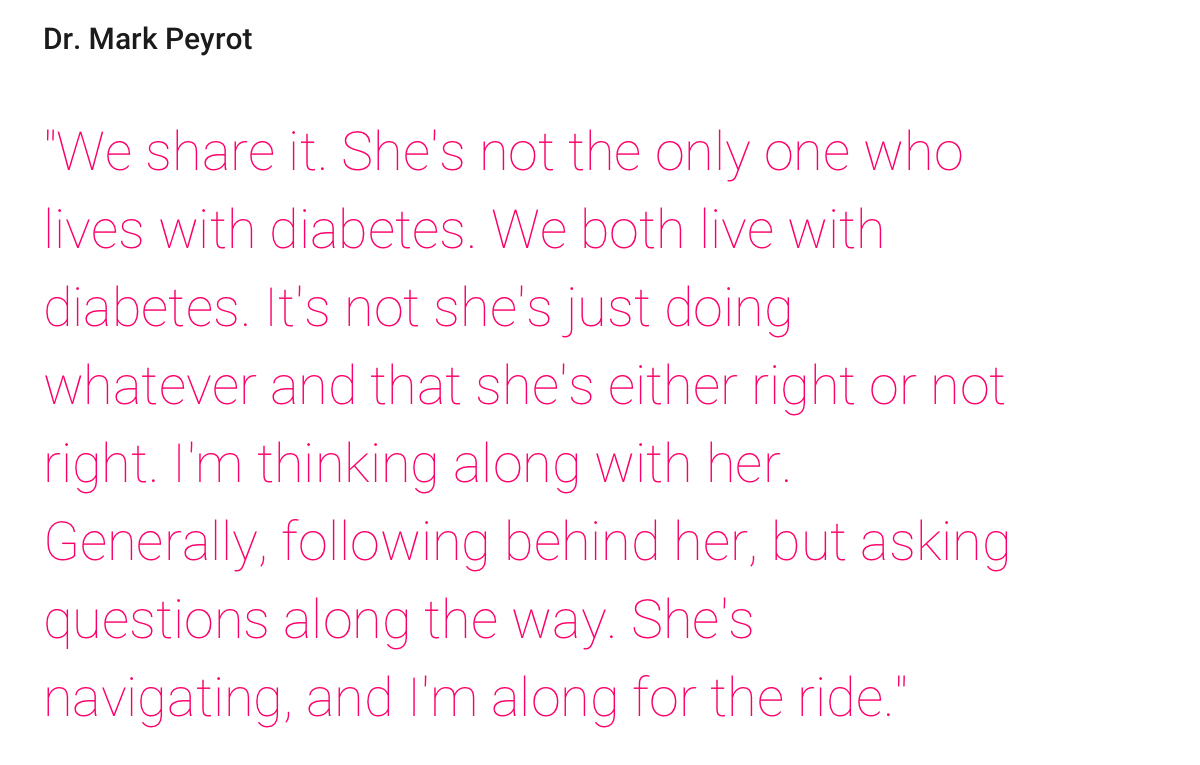Dr. Mark Peyrot, Professor of Sociology, Loyola University of Maryland, has over 300 publications, and is an internationally recognized speaker on the behavioral aspects of diabetes. In collaboration with Novo Nordisk and the International Diabetes Federation, Dr. Peyrot led the Diabetes Attitudes, Wishes and Needs (DAWN/DAWN2) studies.
These studies identified challenges faced by people with diabetes and the people helping them. Dr. Heather Stuckey collaborated with Dr. Peyrot as lead qualitative investigator on the DAWN2 study, and is Assistant Professor of Medicine at Penn State University College of Medicine.
Professionally, both Drs. Peyrot and Stuckey research ways to improve the education, self-management support, and psychological well-being of people with diabetes and their families. Personally, Dr. Stuckey has type 1 diabetes.
In this two-part post, Mark and Heather first talk about their work on the DAWN2 study; then, they share how diabetes affects them both on a personal level.
Part I: Learning from people with diabetes and their families
You both worked on the DAWN2 study, one of the largest global studies understanding the needs of people with diabetes and their families. Who was involved and what did you learn?
Mark: We invited people with diabetes (PWDs) and family members (FMs) from 17 countries. FMs were defined as a household member who supports a PWD. Getting support from a FM resulted in better mental health for the PWD, and FMs benefited from getting support from people beyond the PWD.
The more involved FMs were in diabetes care, the more burdened they felt; however, that burden was offset when FMs were able to provide support in ways that were perceived to be helpful to the PWD.
We assessed a whole range of activities, including doing things with the PWD, doing things for the PWD, giving them advice, telling them when they were doing poorly or when they were doing well.
There was agreement between PWD and the FMs of PWDs, both in terms of the different types of support being done and in terms of what was more or less helpful.
How does diabetes in the home affect family members who don't have diabetes?
Mark: When we looked at the burden of diabetes on FMs, the effect was surprisingly very similar to PWDs. You might think a PWD is carrying all the burden and FMs are protected from that. But, when we looked at different impacts on your life, the numbers were almost identical except for physical health, obviously.

Heather: FMs were very emotional, talking about the PWD's hypoglycemia. They were scared about the PWD being alone and the FM not being around to help. There's great worry and anxiety among FMs surrounding hypoglycemia, whereas the PWD generally had the attitude, “Well, yeah, it's scary, but I live with this every day.”
Mark: We always tend to think of how things impact a person with diabetes. But, there's a cost to caring. It's not just a free resource.
Heather: One of the positive aspects for FMs is the PWD provided inspiration, and helped the FM make positive life changes.
Mark: The FMs would say, “We've put the whole family on a healthier diet. Everybody is eating better because we have someone with diabetes in the family.”

Heather: They would say that the whole family now makes time to exercise, that they have more vegetables and fruits, that the children are paying more attention to what they eat. Someone said, “I followed the PWDs' advice about nutrition and lost over 30 kilos.” The FMs would be proud of the PWD as a role model because managing diabetes requires so much work and emotional challenge.
One of the DAWN2 findings was that family members or support people wanted to help the person with diabetes, but didn't know how. Can you talk about that?
Heather: We didn't ask about this in the open-ended questions, but FMs spontaneously talked about not knowing how to help. FMs wanted to know more about diabetes complications and how to prevent them. They wanted to know about what to eat or not to eat to help the PWD.
Mark: Only about one quarter of the FMs, and only half of the PWD had any formal diabetes education. It was nowhere near what it should be if we want FMs to be really helpful to PWD.
What about other research you've done on this topic?
Mark: We've talked to men and women with diabetes and their spouses. For a man with diabetes, the wife was comfortable putting the family on the so-called “diabetic diet.” But, when she had diabetes, she didn't feel comfortable doing that.
For women, they didn't want to mess up everyone else's life. For a man with diabetes, spouses wanted to take care of him. It's an interesting gendered pattern. Obviously, this isn't always the case, but it does come up quite a bit.
Part II: The DAWN2 results in our day-to-day life
Speaking of spouses, you're both engaged, so let's talk support with diabetes on a more personal level.
Heather: Yes, we were engaged this past year, and now we are both the PWD (me) and FM (Mark). We study what we experience. I was diagnosed with type 1 diabetes at age 12, and I’ve lived with diabetes over three decades!
How have people supported you with your diabetes and how has that affected how you manage your diabetes?
Heather: My family was fairly hands-off about diabetes. I was on my own taking care of it, and I didn't do a good job. I tried to do the food exchanges when I was first diagnosed. I attempted to follow the diet, and then I would alter the diet and see if anyone noticed. Nobody did.
So, I'd feel like, “Alright, I'm just going to do my own thing.”
That attitude continued throughout my teens and early twenties. I became more aware of it when friends started to ask me, “So, how is your diabetes?” It got me thinking that people cared about how I was doing, and maybe I should, too.
My diabetes educator was concerned about me, and I appreciated her help. Then, I got pregnant and I thought, “Now I'm living for this other person too. I really want to do better.” So, for a number of years I worked hard. Then I started back on the track of this is a lot of work.
I'd say in the last 10 years, I've had friends, and now Mark, who are interested in how I'm doing. They provide me with support in ways that are helpful.
What does helpful support look like?
Heather: For me, it's being interested, but not pushy. One thing Mark will do, for instance, is say, “So how much insulin did you take for that?” We'll calculate how many carbs are in the foods in front of us. So, he's learning along with me. It's not just my thing, where I'm doing whatever I think is best.

Mark: It's more that I'm curious, and I'm in this with you. It's not advice.
Heather: I don't take advice well. It's why I'm in the perfect position to be a behavioral scientist because I know what doesn't work.
For me, emotional support is most helpful. I have the practical knowledge. I study this. I know what I need to do. There's some instrumental support with putting on the CGM, so I'll ask Mark for assistance. That's the only thing I usually ask for.

Mark: One twist on that is that my curiosity helps her be more mindful. Because I'll ask questions, “How many carbs is in that?” She'll throw out a number, and then she'll say, “Well, actually, if I think about it, it's this or that.”
Or, I'll ask, “How much insulin did you give for that?” And so, She'll say “this or that.” Basically, in explaining it to me, she has to think more carefully about it than when she's doing the calculations in her head. Sometimes there are discrepancies, and she may feel comfortable giving herself more insulin. In the DAWN study, helpful support was doing things with someone not for someone.

Heather: Sometimes Mark carries juice for me because I don't have pockets or because he feels better if he has juice for hypoglycemia, even though I don't think I need it.
Mark: She had a severe hypoglycemic episode once when we were hiking. We were out hiking in a forest, and I had to run back to our room. I got a cup of water and grabbed a bunch of sugar packs and dumped the sugars into the water and stirred it up. Ran back, and she drank it and recovered quickly.
Heather: And that was the weirdest hypo I've ever had in my life. We had eaten and eaten, and I kept eating because I was certain my blood sugar would go up, but it never did. It went lower and lower.
Mark: Since then, there's always juice in the car. She knows herself better than I do, so she's more comfortable with being less cautious, whereas I'm not as comfortable. Of course, the vast majority of the time, she goes, “See I didn't need it.” That’s OK -- I'm still taking it with me -- might as well be prepared.
Heather: He'll say, “I'm going to take the juice anyway because it's more for me than you.” I'm OK with that. Whatever makes him feel better. And if the tables were turned, and he had diabetes, I would carry juice for him too.
How does diabetes affect your interactions as a couple?
Heather: I like that Mark pays attention to my diabetes, but sometimes he'll forget that I can't see well, especially at night. I have diabetic retinopathy. When he doesn't remember, I'll nudge or remind him of that.
Mark also has a different eating pattern than I do. He prefers to not have much for breakfast or lunch, and then to eat more at night. I'm the opposite. I like to have more at breakfast and lunch and not that much at night. It's been an adjustment for both of us to work through things like that.
How does a personal connection to diabetes affect your professional life?
Mark: I've learned more about the details that I didn't know as a behavioral scientist. I knew them in a vague way, but I didn't know how many carbs are in this or that. I used to think calories played more of a role, but they don't.
Heather: We'll have a barbeque, and he'll say, “So it's just the bread, right?” I'll say, “Yes, it's bread, but this sauce has more carbs than a chocolate cake.” And, then he's like, “No way!”
Mark: Heather's also my key informant. It's led to a lot of innovative ideas to help more people with diabetes.
How has Heather's diabetes affected you personally?
Mark: It's a shared experience. The sharing's incomplete, but I can look up how she's doing on the Dexcom app.
Heather: I put him on notifications for extreme, urgent lows. He gets pinged because it may mean I'm not functioning as well as I could be. Sometimes I look at the number and I say, “This is high. Damn it.” Then, he'll say, “So what's your number?” Then silence. I may say, “It's high. It's too high.” It's like, man, I screwed that up. If I share that my blood sugar is high, I feel shame. It's not that Mark makes me feel that way. It's rooted in all the doctors telling me over the years that my numbers aren't where they should be.
Mark: I want to see her do better. I empathize with her, so when she's not doing well, I kind of feel the same thing. The one exception is the severe hypos because it triggers an emergency response. It becomes my problem too. Also, she has concerns about her future, but she's younger than I am.
Heather: I feel like I have a body that's as old as his body. I've added so many medical issues to my body.
Mark: Except she exercises every day.
Chandra: I know, I saw her at the gym. (laughter)
What recommendations do you have for people with diabetes and their support people?
Heather: For support people, ask the person with diabetes, “What support can I give you? I want to care, and I want to support you, but I don't know how.” This helps to avoid conflict and a nagging situation. People can say, “I don't want to take ownership of your diabetes, but I want to be there and show that I care.
How can I do that?” Mark does that by being curious. That relates to me because I'm curious, too. Instead of saying, “You didn't take enough insulin for that,” he'll say, “I'm just curious, I don't know how many carbs were in that, how many carbs do you think were in that?” It gets to the same endpoint, but in a more positive way.

Mark: We share it. She's not the only one who lives with diabetes. We both live with diabetes. It's not that she’s either right or not right in what she does. I'm thinking along with her. Generally, following behind her, but asking questions along the way. She's navigating, and I'm along for the ride.




